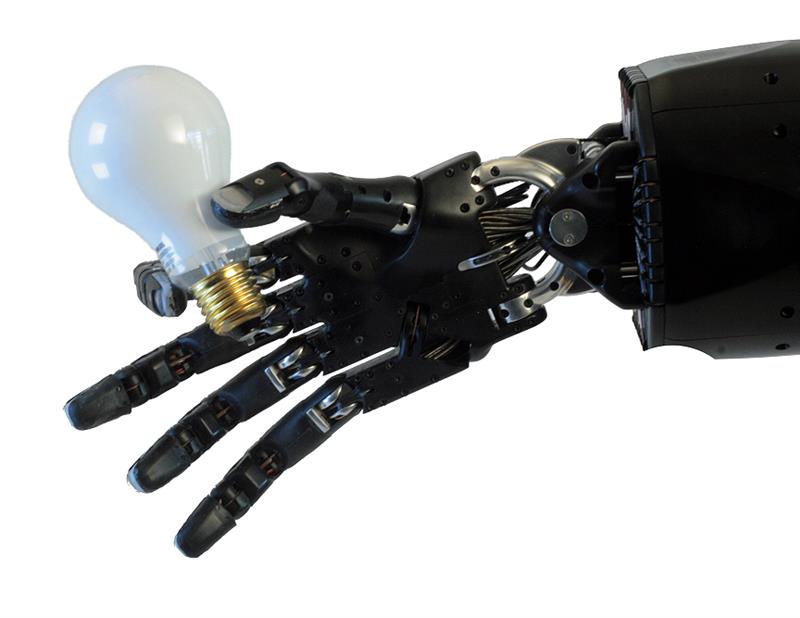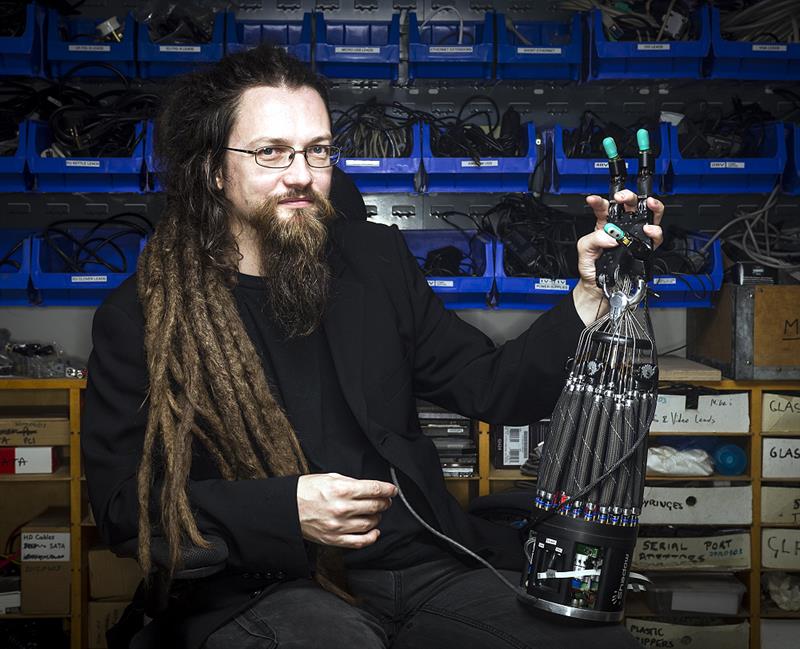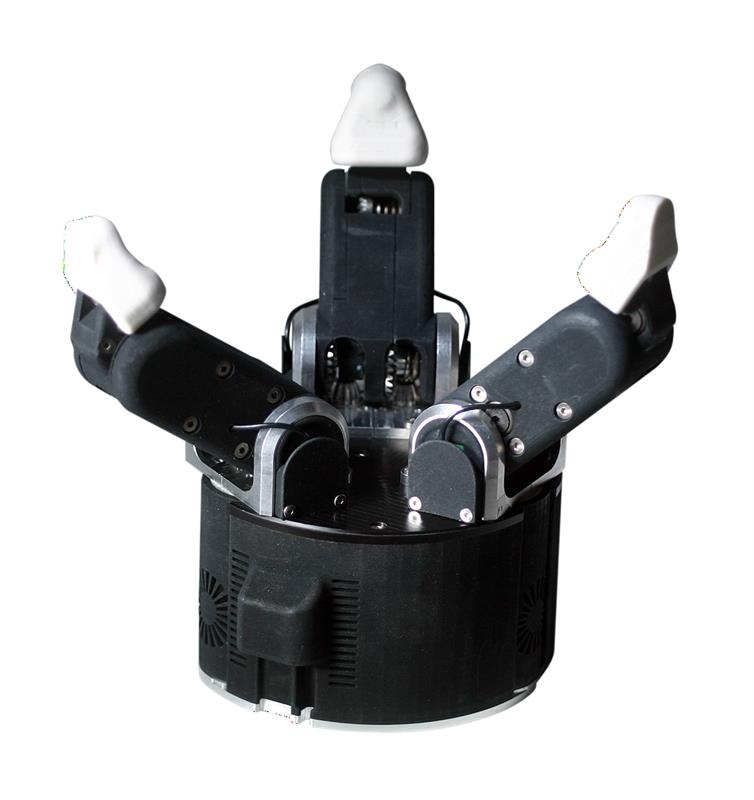We are not only seeing the convergence of information technology and operations technology, but also robot manufacturers and communication and software providers coming together, leading to more human-robot collaboration.
Big Data – the rise of digital factories, a rapidly evolving supply chain, Industry 4.0 and emerging economies of scale – is set to completely transform the way in which manufacturing operations are carried out. And industrial robots are being seen as the ‘arms and legs’ of Big Data.
Meanwhile, as more industrial robots are being deployed, this will require factories to make better use of the available floor space. In order to do this, robots will have to collaborate to a much greater extent and this will need them to have built in intelligence.
London based Shadow Robot – one of a number of companies working with Innovate UK – is developing a Smart Grasping System (SGS) which enables robots to operate with a ‘grasping’ action, rather than by ‘gripping’.
“Humans are excellent graspers, but despite decades of research on robotic grasping, we have yet to establish the same level of competency in robotic systems,” says Rich Walker, the company’s managing director. “Robots that ‘grasp’ are hard to program and, while there are examples, they tend to be ‘clunky’ when operated. It needs sensitive control and joint motion.
“People have been calling for something a lot simpler than what currently exists and a lot less expensive.”
The SGS developed out of a collaborate effort, part of the European Horizon 2020 project, established to deliver improved patient care.
“We are focused on developing a system capable of picking things up well, of picking up new and variable objects and doing so cleanly, but also without having to employ extensive technical support. The robot also needs to be able to communicate with the wider production management system.

“When combined with built-in intelligence, it will have the ability to operate like a human hand,” Walker explains. “Manipulation is the key requirement, but keeping it simple has proved hard in term of programming.”
Unlike traditional ‘grippers’, which are designed to perform one specific function, the Shadow Robot variant is capable of using a variety of grasps, allowing it to handle a much broader range of objects.
The system comes with a library of different grasps, an in-built vision system that enables it to ‘see’ what it is about to grasp and torque sensing in each joint. It has also been designed to be easy to use.
The SGS deploys sensors that monitor the torque in the springs of the various joints. Each joint can then be controlled separately and different levels of torque applied.
“The ability to deploy torque sensing means the hand can make a more accurate and reliable grasp. Ease of use means that it is easy to program,” Walker says. “The system has the intelligence to know what it’s grasping and to select the correct grasp for that particular object.”
The key thing about the Smart Grasper, according to Walker, is that it can ‘sense, interpret and then act’.
Walker says the industrial market has been calling for an accurate gripper and believes the SGS provides a practical solution to a real-world manufacturing problem.
Part of the world’s largest online only grocery retailer, Ocado Technology has been working with universities from across Europe to develop innovative robotic solutions and has recently unveiled a robotic grocery picking solution for its highly-automated warehouses.
Ocado’s robotics team has created a device which can safely grasp a variety of products. In order to avoid damaging sensitive and unpredictably shaped grocery items, the arm uses the principle of environmental constraint exploitation to establish a carefully orchestrated interaction between the hand, the object being grasped and the item’s environment.
According to Dr Graham Deacon, Ocado’s robotics research team leader: “We are pursuing a new direction for robotic grasping by developing robot hands.”
Ocado is also involved in designing a collaborative robot that can learn from and offer assistance to warehouse maintenance technicians in a proactive manner.

The wealth of data available means that it is possible to build more intelligence into the production process, whether that is derived from mapping vision, human motion and emotion, or human skills such as how humans handle objects across to robots.
All of this requires embedded sensing technologies and high speed microcontrollers capable of processing and using this intelligence.
The rise of Industry 4.0 means that, for many businesses, manufacturing flexibility and the ability to handle limited batch numbers will be crucial.
“Industry 4.0 is an interesting opportunity for our robotic technology. It’s all about flexibility and requires all the production stations to know what is coming down the production line. It will need to have the ability to manage different shapes and a gripper capable of handling that,” Walker explains (pictured right).
Combining an intelligent gripper with digital modelling or 3D modelling, for example, or linking it to 3D cameras and embedded learning capabilities, will provide more flexibility and intelligence.
“Manufacturers will want to be able to adapt their machines and robots easily and efficiently in light of that intelligence,” suggests Walker.
“Programming a gripper to do a simple action is straightforward. But if you need it to do a more complicated task, factories are currently obliged to purchase new grippers in order to perform it. That’s time consuming and expensive,” he explains. “The library we have created includes a large number of different grasps, which means you don’t need multiple machines, saves money and reduces the floor space required. You will be able to install these robots across multiple sites via an easy to use interface with a simple setup.”

With intelligence embedded into the ‘hand’, Walker says the company has taken an Internet of Things approach by putting the intelligence into the hardware.
“Another benefit is that the SGS (left) is modular. That means it can be used with existing robotic arms or platforms and with existing processes – eliminating unnecessary costs,” he suggests. “You’ll require fewer robots, fewer spare parts, less training for staff and less human cost.”
He argues that, as these robots are able to work more efficiently and independently, their human operators or minders can then be deployed on higher-level tasks.
“Robotic hands will be responsible for low level tasks, helping to solve real-world manufacturing problems by being both intelligent and far more flexible when it comes to re-tooling.
“We can, as a result, be far more creative when it comes to developing innovative manufacturing processes that enable businesses to fully exploit the concepts that underpin Industry 4.0,” he concludes.













